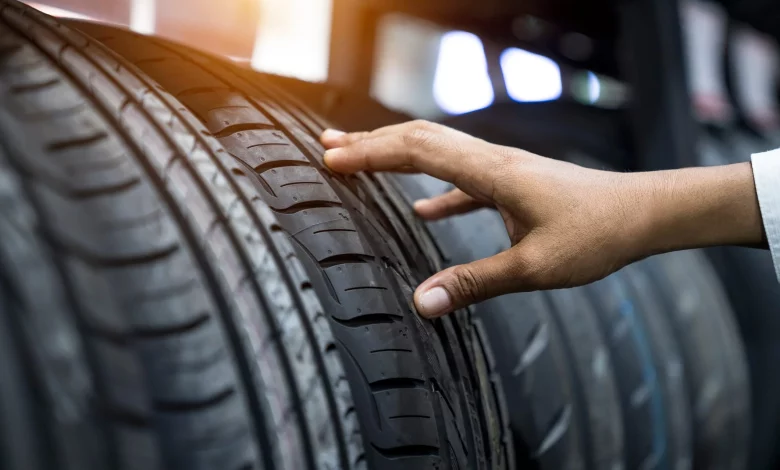The Science of Tires: How to Choose the Right Ones

Tires are one of the most important components of a vehicle, as they directly impact its performance and safety. The right tires can enhance your car’s handling, fuel efficiency, and overall ride comfort, while the wrong ones can negatively affect your vehicle’s performance and put your safety at risk. In this article, we’ll explore the science of tires and provide tips on how to choose the best ones for your car.
I. Introduction
When it comes to selecting the right tires, there are several factors to consider. These include weather conditions, road conditions, driving style, and the type of vehicle you own. Before delving into these factors, let’s take a look at some tire basics.
II. Tire Basics
Tires are made up of several components, including the tread, sidewall, beads, and plies. The tread is the outermost layer of the tire and provides traction and grip on the road. The sidewall supports the weight of the vehicle and protects the tire from damage. The beads are two hoops of steel wire that anchor the tire to the wheel, while the plies are layers of fabric that give the tire its structure and strength.
There are three main types of tires: summer, winter, and all-season. Summer tires are designed for warm weather and provide excellent traction on dry and wet roads. Winter tires are ideal for cold and snowy conditions, as they have a special tread pattern that provides better grip on slippery surfaces. All-season tires are designed to perform well in a variety of weather conditions, but they don’t excel in any one area.
Tire size is also an important consideration when selecting tires. The size is indicated by a series of numbers and letters on the sidewall of the tire. This information includes the tire width, aspect ratio, and rim diameter.
III. Factors to Consider When Choosing Tires
When selecting tires, there are several factors to consider. These include climate and weather conditions, road conditions and driving style, vehicle type and weight, and budget and cost.
Climate and weather conditions: The climate and weather conditions in your area should be a primary consideration when selecting tires. If you live in a region with hot summers and mild winters, summer tires may be the best option. However, if you live in an area with cold and snowy winters, winter tires are a better choice. All-season tires are a good option for areas with mild weather conditions.
Road conditions and driving style: The road conditions and your driving style can also impact your tire selection. If you frequently drive on rough or unpaved roads, you’ll need tires that can handle these conditions. If you have a sporty driving style, you’ll need tires that provide excellent handling and grip.
Vehicle type and weight: The type of vehicle you own and its weight can also impact tire selection. Larger vehicles require larger and more durable tires that can support their weight. Sporty vehicles may require tires with a softer compound for better handling.
Budget and cost: Finally, your budget and cost will also impact your tire selection. Higher-end tires tend to be more expensive, but they may provide better performance and durability.
IV. Tire Performance Ratings
To make informed tire choices, it’s important to understand tire performance ratings. These ratings measure the tire’s ability to perform in specific areas, including treadwear, traction, and temperature.
Treadwear: Treadwear is a rating that indicates how long the tire will last. The higher the number, the longer the tire will last.
Traction: Traction is a rating that indicates how well the tire can grip the road. The rating is graded from AA (highest) to C (lowest).
Temperature: Temperature is a rating that indicates how well the tire can handle heat.
V. Choosing the Right Tires for Your Vehicle
Now that you understand the basics of tire structure and the factors to consider when choosing tires, it’s time to select the best ones for your vehicle. Here’s a step-by-step guide to help you make the right choice:
- Check your vehicle owner’s manual for the recommended tire size and type.
- Determine the driving conditions you’ll encounter most often, including weather and road conditions.
- Consider your driving style and vehicle type.
- Research tire brands and models that fit your needs and budget.
- Compare prices and look for discounts or special offers.
- Schedule an appointment with a reputable tire dealer to have your new tires installed.
When shopping for tires, it’s important to avoid low-quality or counterfeit tires, as they can pose a serious safety risk.
Related: How to Troubleshoot Sensor Issues in Your Car
VI. Maintaining Your Tires
Once you’ve selected the right tires for your vehicle, it’s important to properly maintain them to ensure optimal performance and safety. Here are some tips for maintaining your tires:
- Check your tire pressure regularly and keep them properly inflated.
- Rotate your tires every 5,000 to 8,000 miles to ensure even wear.
- Check your tires for signs of wear, including cracks, bulges, and punctures.
- Have your tires balanced and aligned regularly to ensure smooth handling and even wear.
- Replace your tires when the tread depth reaches 2/32 of an inch or if they are more than six years old, regardless of the amount of wear.
By properly maintaining your tires, you can extend their lifespan and ensure your safety on the road.
VII. Conclusion
Choosing the right tires for your vehicle is essential for optimal performance and safety. By considering factors such as weather conditions, road conditions, driving style, and budget, you can select the best tires for your needs. It’s also important to understand tire performance ratings and to properly maintain your tires to ensure their longevity and safety. With the right tires and proper maintenance, you can enjoy a smooth and safe ride every time you hit the road.
Follow cash for cars Caboolture for more updates.




